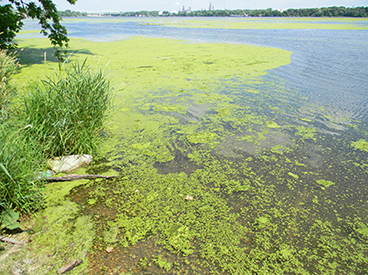
| Oct. 2015 | |||||||||||
| Top stories | |||||||||||
| In the news | |||||||||||
| Photos | |||||||||||
| Contact us | |||||||||||
| Archive | |||||||||||
|
Municipalities checking water for blue-green algae |
This has been a record-setting year for the number of harmful blue-green algal blooms in Iowa’s ponds and lakes. Algal blooms create a smelly scum on the surface of water, and toxins produced by algae threaten the health of those exposed to it. As of Sept. 3, 34 state park beach advisories were issued for toxin levels that exceeded the World Health Organization’s recommended level of 20 ug/l (micrograms per liter), breaking the previous record of 24 in 2013. Suspected exposure to these algal blooms is reportable to the Iowa Department of Public Health.
 Algal blooms in the Lower Des Plaines River, photo by Cindy Skrukrud
Algal blooms in the Lower Des Plaines River, photo by Cindy SkrukrudBlue-green algae produces a bacteria called cyanobacteria. Municipalities now are questioning if source water for public water supplies contain cyanobacteria toxins. The Hygienic Laboratory is helping them find the answer.
For more than a month, the lab has been using an immunoassay screening to test the algae for microcystins and can also test for cylindrospermopsin. The toxins can cause illness such as nausea, vomiting and diarrhea, and, in severe cases, kidney and liver failure. People, pets and other animals can be affected.
Michael Wichman, director of the Environmental Health Division, said the lab has been receiving water samples at least weekly from a few public water systems "who want to protect the public from these toxins." The services also are available to individuals or organizations wanting to test private lakes or ponds.
With the immunoassay screening, staff members use a freeze-thaw cycle to break the cells to release the toxins, if they are present, a process that can take two to three hours.
Harmful algal blooms can form in warm, slow-moving bodies of water that are rich in phosphorus and nitrogen from fertilizer runoff, septic tank overflows, manure and other sources that have washed into the waterways. The surface scum can look like spilled paint, or discoloration and may have green globs floating beneath the surface.
Even when the algal bloom disappears, the toxins can remain in the water. Climate change and warmer average temperatures are thought to be associated with the increase in algal blooms.
There are no national standards for algal toxins in drinking water, and U.S. utilities are not required to test for them. Wichman said several algal toxins are proposed for monitoring under a forthcoming Environmental Protection Agency unregulated contaminant monitoring rule (UCMR4).
An EPA-certified facility, the Hygienic Laboratory conducts testing of drinking water as mandated by the Safe Drinking Water Act. The staff is also in the process of validating and implementing methods to test for certain toxins, Wichman said.
Wichman said Iowans should stay out of bodies of water with harmful algal blooms (or wash immediately after coming in contact with them) and install fountains or other means to mitigate water stagnation.
For the long-term, Iowa citizens should reduce the nutrient loads that enter the state's waterways, he said.